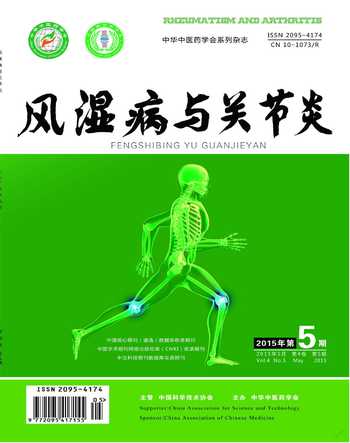强直性脊柱炎患者血清Dkk—1水平与骨影像学变化的相关分析
谢建民 赵成



【摘 要】目的:探讨强直性脊柱炎患者血清Dickkopf-1(Dkk-1)的水平及其诊断价值,了解Dkk-1与强直性脊柱炎炎症及放射学进展的关系。方法:选取接受注射用重组人Ⅱ型肿瘤坏死因子受体-抗体融合蛋白(益赛普)治疗的强直性脊柱炎患者55例为强直性脊柱炎组,同期45例健康体检者作为对照组。随访2年,分别在基线状态、治疗24个月时评估强直性脊柱炎患者各项临床指标[年龄、性别、疾病活动度(BASFI、BASDAI、BASMI、BASRI)]、影像学进展(mSASSS)以及炎症指标[红细胞沉降率(ESR)、C-反应蛋白(CRP)]。采用ELISA法检测强直性脊柱炎患者血清Dkk-1浓度。运用相关分析法分析Dkk-1与疾病活动度、影像学进展及炎症指标的关系。结果:强直性脊柱炎组在基线状态时,ESR及血清CRP水平高于对照组,但Dkk-1浓度(72.6±19.5)pg·mL-1低于对照组(98.0±27.6)pg·mL-1(P < 0.01);强直性脊柱炎组在治疗24个月时,ESR及血清CRP水平较基线状态时明显下降(P < 0.01),治疗24个月时,BASFI、BASMI和BASDI评分较基线状态时明显改善(P < 0.01),但在治疗24个月时,Dkk-1浓度为(74.2±15.3)pg·mL-1,较基线状态时稍有升高(P = 0.57),仍低于对照组(98.0±27.6) pg·mL-1(P < 0.01)。ROC曲线分析显示,Dkk-1水平69.75 pg·mL-1为截断点,该点诊断的敏感度为84.02%,特异度为91.50%,曲线下面积(AUC)为0.94,诊断效力高。相关分析显示,强直性脊柱炎组患者在基线状态时和治疗24个月时,血清Dkk-1水平与ESR、CRP、BASFI、BASMI以及BASDAI评分无明显相关性。而放射学指数BASRI及影像学mSASSS评分在基线状态和治疗后差异无统计学意义(P > 0.01),且mSASSS评分与Dkk-1水平在基线状态和治疗24个月时呈显著负相关(r = -0.78,P < 0.01)。结论:肿瘤坏死因子拮抗剂对强直性脊柱炎患者血清Dkk-1水平无明显改善,血清Dkk-1水平与放射学变化明显相关,提示血清Dkk-1的产生可能与炎症状态无明显相关性,Dkk-1可能参与了强直性脊柱炎的骨化形成;肿瘤坏死因子拮抗剂可能对强直性脊柱炎骨化进程无明显阻止作用,强直性脊柱炎患者血清Dkk-1可作为一种新的反映骨化指标及影像学进展的血清生物标志物。
【关键词】 脊柱炎,强直性;血清;Dkk-1;骨化;影像学;疾病活动度;炎症指标;益赛普
doi:10.3969/j.issn.2095-4174.2015.05.003
【ABSTRACT】Objective:To investigate the serum Dkk-1 level and its diagnostic value in patients with ankylosing spondylitis to learn the relationship between Dkk-1 and bone imaging changes.Methods:Chose 55 cases of ankylosing spondylitis treated with Yisaipu (Recombinant Human Tumor Necrosis Factor-α ReceptorⅡ:Igg Fc Fusion Protein) as the ankylosing spondylitis group,and 45 healthy subjects as the control group.During the 2 years of follow-up,evaluated,respectively at baseline and after 24 months of treatment,the clinical index (age,gender,disease activity:BASFI,BASDAI,BASMI,BASRI),radiographic progression (mSASSS) and inflammatory index (ESR,CRP) of the patients with ankylosing spondylitis.ELISA method was used to detect serum Dkk-1 concentration of ankylosing spondylitis patients.Relative analysis Methods were used to analyze the relationship between Dkk-1 and disease activity,radiographic progression and inflammatory biomarkers.Results:ESR and serum CRP levels of the ankylosing spondylitis group were higher than those of the control group at the baseline,but the concentration of Dkk-1(72.6±19.5) pg·mL-1 was lower than that of the control group (98.0±27.6) pg·mL-1(P < 0.01).At the 24 th month of treatment,ESR and serum CRP level of the ankylosing spondylitis group significantly decreased (P < 0.01)than those of at the baseline,while BASFI,BASMI and BASDI were significantly improved(P < 0.01) compared with those at the baseline.After 24 months of treatment,the concentration of Dkk-1 (74.2±15.3)pg·mL-1 was slightly increased(P = 0.57) compared with that at the baseline,but still lower than the control group (98.0 ± 27.6)pg·mL-1(P < 0.01).ROC curve analysis showed that the level of Dkk-1(69.75 pg·mL-1) was the cut-off point,whose diagnostic sensitivity was 84.02%,specificity was 91.50%,and area under curve (AUC) was 0.94,with high efficiency of diagnosis.Correlation analysis showed that at the baseline and after 24 months of treatment,there was no significant correlation between the serum level of Dkk-1 and ESR,CRP,BASFI,BASMI and BASDAI.The BASRI and mSASSS score had no significant differences at the baseline and after treatment(P > 0.05),and there was a significant negative correlation(r = -0.78,P < 0.01) between the scores of mSASSS and the Dkk-1 levels at the baseline and after 24 months of treatment.Conclusion:Tumor necrosis factor antagonist cannot significantly improve serum Dkk-1 level in patients with ankylosing spondylitis,and the level of serum Dkk-1 correlates with the radiographic changes,suggesting that the generation of serum Dkk-1 has no significant correlation with the inflammatory state,and Dkk-1 may be involved in ankylosing spondylitis ossification.Tumor necrosis factor antagonist may have no obvious preventive effect on the ossification process,and serum Dkk-1 in patients with ankylosing spondylitis can be regarded as a biomarker to reflect the ossification indexes and iconographical progress.
【Keywords】 spondylitis,ankylosing;serum;Dkk-1;ossification;iconography;disease activity degree;inflammation index;Yisaipu
强直性脊柱炎(ankylosing spondylitis,AS)是一种以附着点炎及韧带骨赘形成为主要病理特征的慢性进展性炎性疾病[1-2]。韧带骨赘生成是AS患者影像学结构破坏的标志性特征,也是影响患者机体功能和脊柱活动度的主要因素,最终可导致进展性脊柱强直及活动受限。目前,骨赘形成的机制尚不清楚。新近研究发现,Wnt信号通路在骨形成方面起重要作用,可能参与了AS韧带骨赘的形成[3]。
Dickkopf-1(Dkk-1)是Wnt信号的天然阻断因子,对Wnt介导的骨重塑过程起关键的调节作用,Dkk-1可直接干扰Wnt/β-catenin通路的信号转导过程,抑制Wnt介导的成骨作用,从而使骨形成减少[4-5]。目前,Dkk-1是否影响韧带骨赘的形成及其在AS发病机制中的意义尚不明确。韧带骨赘形成及椎体骨性强直是AS的特征性表现,传统的X线检查被认为是定量评价AS患者脊柱结构变化的金标准。新近研究认为,修订版斯托克脊柱评分(mSASSS)是目前评价AS脊柱骨化进展最有效、可靠、敏感的影像学指标[6-7],且与AS患者的活动功能相关,故本研究采用mSASSS评价患者的影像学进展。为此,本研究观察AS患者血清Dkk-1水平在肿瘤坏死因子(TNF)拮抗剂治疗前后与AS相关的临床指标BASDAI、BASFI、BASMI、BASRI、mSASSS,及血清中炎症指标如红细胞沉降率(ESR)、C-反应蛋白(CRP)水平等的关系,以期为AS的治疗及诠释骨赘形成机制提供新的思路。
1 临床资料
1.1 一般资料 选取2012年5月至2014年12月本院风湿科收治的55例AS患者为AS组,同期健康体检者45例为对照组(无心血管疾病、肝肾疾病、风湿性疾病、炎症及感染)。所有AS患者给予24个月的注射用重组人Ⅱ型肿瘤坏死因子受体-抗体融合蛋白(益赛普,上海中信国建药业股份有限公司,国药准字S20050058)每次25 mg,每周2次,皮下注射治疗,由风湿专科医师指导用药及决定疗程。
1.2 纳入标准 AS患者均符合1984年修订的纽约诊断标准,尽量避免因病情活动造成的选择偏倚。
1.3 排除标准 ①合并心血管疾病、感染和其他风湿性疾病者;②不能提供研究所涉及的各项临床资料及检测结果者。
2 方 法
2.1 血清保存及检测 抽取AS组患者及对照组的静脉血,置于真空非抗凝管,30 min内迅速保存于-20 ℃,并在1个月内通过离心获取上层血清后转移到-80 ℃长期保存。血清Dkk-1浓度检测采用酶联免疫吸附试验(ELISA),试剂盒购自美国ADL公司。严格按照试剂盒说明操作,酶标仪测定吸光度(A),测定波长为450 nm。
2.2 影像学进展评价 分别由2位有5年影像诊断工作经验者根据mSASSS在基线状态和治疗
24个月时进行盲法评分。mSASSS由腰椎评分和颈椎评分组成,总分0~72分。①腰椎评分:包括12胸椎、5个腰椎、骶椎上段。侧位片。0分,正常;1分,侵蚀、硬化或方形变;2分,韧带骨赘;3分,全椎体骨桥形成,竹节样脊柱。所有病变点评分取平均值,乘以12为总分(0~36分)。②颈椎评分:第2颈椎下段至第1胸椎上缘,第3颈椎由于其生理性凹面较小,方形变不评分,其余病变评分。评分方法与腰椎相似,总分为0~36分。③骶髂关节平片:根据1984年修订的纽约标准X线表现分级。
2.3 统计学方法 采用SPSS 19.0软件进行统计分析。正态分布且方差齐的计量资料以表示,组间比较采用成组设计t检验或秩和检验;计数资料组间比较采用r检验;相关分析采用Spearman检验;将血清Dkk-1与mSASSS评分进行受试者工作特征(ROC)曲线分析,评价其对诊断冠脉钙化的敏感度和特异度。以P < 0.05为差异有统计学意义。
3 结 果
3.1 AS组在基线状态时与对照组临床和实验室资料比较 AS组年龄、性别、BMI指标与对照组比较,差异无统计学意义(P > 0.05),ESR及CRP水平明显高于对照组,而血清学Dkk-1水平明显低于对照组(P < 0.01)。见表1。
3.2 AS组在TNF拮抗剂治疗24个月时与基线状态时各临床指标比较 AS组共54例患者完成24个月治疗,54例患者治疗24个月时,ESR、CRP、BASDAI、BASFI、BASMI指标均比基线状态时明显改善,但Dkk-1浓度较基线状态时稍有升高(P = 0.57),仍低于对照组(P < 0.01)。而放射学指数BASRI及影像学mSASSS评分在基线状态和治疗24个月时比较,差异无统计学意义(P = 0.15,0.21,0.69)。见表2。
3.3 用ROC曲线确定血清Dkk-1的最佳临界点 在ROC曲线下,mSASSS评分骨化的最佳血清Dkk-1的界值为69.75(曲线下面积为0.86,95%CI = [0.78,0.86],对应的敏感度为84.02%,特异度为91.50%。见图1。
3.4 AS患者血清Dkk-1水平与各指标的相关性 Spearman相关分析显示,AS患者血清Dkk-1水平与ESR、CRP、BASDAI、BASFI均无明显相关性(P > 0.05)。但与影像学mSASSS评分呈明显负相关(r = -0.808,P < 0.01)。当mSASSS < 10时,二者无明显相关性(r = -0.093,P = 0.63);当mSASSS > 10时,二者呈明显负相关(r = -0.78,P < 0.01),见图2、图3。
4 讨 论
Dkk-1于1998年首次在两栖动物非洲蟾蜍胚胎细胞中被发现,编码为Dkk-1,是一种强大的Wnt信号通道的拮抗剂,随后的研究证实,人类的Dkk-1基因位于10号染色体10q11上。Dkk家族共有4种:Dkk-1、Dkk-2、Dkk-3和Dkk-4,除了DKK-3外,其余均为Wnt/β-catenin阻断剂,其中Dkk-1的作用最强。既往研究发现,Dkk-1通过与Wnt信号转导途径相应的受体结合来调控细胞的分化、增殖、迁移或癌变等特性,在肿瘤发生方面发挥重要作用。目前,Uderhardt等[13]利用小鼠类风湿关节炎模型研究发现,以Dkk-1的特异性抗体中和小鼠关节内的Dkk-l后小鼠血清中的骨保护素显著增加,关节局部破骨细胞数明显减少,骨吸收被抑制。用Dkk-l反义寡核苷酸治疗可抑制破骨细胞分化刺激因子的表达和破骨细胞的分化。这些研究提示,Dkk-l是体内骨平衡的负向调节者,推测抑制Dkk-1可能为治疗骨量丢失提供了新的思路。
新近研究发现,Wnt信号通路可能参与了AS患者韧带骨赘的形成[3,14]。Dkk-1是Wnt信号的阻断因子,干扰其与Wnt蛋白结合而阻断该通路,从而使骨形成减少。然而,Dkk-1是否参与了AS骨赘形成目前还不清楚。有研究发现,AS患者血清Dkk-1水平明显低于对照组[15],而且骨赘形成组Dkk-1水平低于无骨赘形成组,而类风湿关节炎患者Dkk-1水平明显高于对照组,其与骨细胞死亡无明显相关性[16-17]。本研究也证实了AS组患者血清Dkk-1水平明显低于对照组,还发现血清Dkk-1水平与炎症指标ESR、CRP、BASDI、BASFI无明显相关性。为进一步探讨TNF与Dkk-1之间的关系,笔者对入组的AS患者进行24个月的TNF拮抗剂治疗,观察治疗前后血清Dkk-1的变化,结果发现,AS组患者血清Dkk-1水平略有升高,和治疗后比较,差异无统计学意义(P > 0.05),这些结果提示血清Dkk-1水平的产生与炎症无明显相关性,其产生可能存在其他机制。既然Dkk-1与AS的炎症没有相关性,那么它是否可以作为诊断AS的血清学指标?为此,采用ROC曲线分析方法确定Dkk-1水平在AS诊断的价值,结果发现,曲线下面积为0.94,说明诊断准确性中等,曲线下面积与AUC = 0.5比较,差异有统计学意义(P < 0.01),说明Dkk-1在AS骨化患者中有诊断价值。
影响AS骨化形成的因素非常复杂,正确估计AS骨化程度对患者诊断、预后及治疗起着重要指导作用[18]。目前临床上对AS骨化的评估主要依赖影像学表现。影像学mSASSS评分系统被认为是目前评价AS韧带骨化最敏感有效的影像学指标,mSASSS评分的高低与AS患者的韧带骨化程度具有良好相关性,能较准确地反映AS的骨化程度。基于以上临床研究,本研究检测了AS组患者Dkk-1水平,并观察了其与放射学评分之间的相关性,结果表明,随着mSASSS评分的增加,血清Dkk-1水平呈下降趋势,二者具有明显的负相关性。24个月TNF拮抗剂治疗后,mSASSS积分与治疗前差异无统计学意义(P > 0.05),这些结果都提示了TNF拮抗剂可能对AS骨化进程无明显阻止作用;而血清Dkk-1水平可作为反映AS脊柱骨化的指标,尤其是在AS病程后期。
总之,本研究结果提示,AS患者血清Dkk-1水平可作为一种新的反映骨化进展的生物学标志物,可能是预测骨化的独立危险因素之一。Dkk-1的发现为研究开发抑制AS骨赘形成的药物提供了新的思路;通过上调Dkk-1基因的表达来抑制骨化的形成,将成为治疗AS韧带骨化的新手段。随着对Dkk-1研究的进一步深入,通过阻断Dkk-1实现组织工程骨诱导的研究也必将取得新的突破,一种新的更有效的治疗骨化疾病的方法也将诞生。
5 参考文献
[1] Maksymowych WP,Chiowchanwisawakit P,Clare T,et al.Inflammatory lesions of the spine on magnetic resonance imaging predict the development of new syndesmophytes in ankylosing spondylitis:evidence of a relationship between inflammation and new bone formation[J].Arthritis Rheum,2009,60(1):93-102.
[2] Rudwaleit M,Haibel H,Baraliakos X,et al.The early disease stage in axial spondylarthritis:Results from the German Spondyloarthritis Inception Cohort[J].Arthritis Rheum,2009,60(3):717-727.
[3] Wendling D,Claudepierre P.New bone formation in axial spondyloarthritis[J].Joint Bone Spine,2013,80(5):454-458.
[4] Baron R,Rawadi G.Targeting the Wnt/beta-cateninpathway to regulate bone formation in the adultskeleton[J].Endocrinology,2007,148(6):2635-2643.
[5] Poole KE,van Bezooijen RL,Loveridge N,et al.Sclerostin is a delayed secreted product of osteocytes that inhibits bone formation[J].FASEB J,2005,19(13):1842-1844.
[6] Ramiro S,Stolwijk C,van Tubergen A,et al.Evolution of radiographic damage in ankylosing spondylitis:a 12 year prospective follow-up of the OASIS study[J].Ann Rheum Dis,2015,74(1):52-59.
[7] Ramiro S,van Tubergen A,Stolwijk C,et al.Scoring radiographic progression in ankylosing spondylitis:should we use the modified Stoke Ankylosing Spondylitis Spine Score (mSASSS) or the Radiographic Ankylosing Spondylitis Spinal Score (RASSS)?[J].Arthritis Res Ther,2013,15(1):R14.
[8] Balemans W,Ebeling M,Patel N,et al.Increased bone density in sclerosteosis is due to the deficiency of a novel secreted protein (SOST)[J].Hum Mol Genet,2001,10(5):537-543.
[9] Diarra D,Stolina M,Polzer K,et al.Dickkopf-1 is a master regulator of joint remodeling[J].Nat Med,2007,13(2):156-163.
[10] Simpson CA,Foer D,Lee GS,et al.Serum levels of Dkk-1,Dickkopf-1,and secreted frizzled-related protein-4 are not changed in individuals with high bone mass causing mutations in LRP5[J].Osteoporos Int,2014,25(10):2383-2388.
[11] Ominsky MS,Vlasseros F,Jolette J,et al.Two doses of sclerostin antibody in cynomolgus monkeys increases bone formation,bone mineral density,and bonestrength[J].J Bone Miner Res,2010,25(5):948-959.
[12] Stolina M,Dwyer D,Niu QT,et al.Temporal changes in systemic and local expression of bone turnover markers during six months of sclerostin antibody administration to ovariectomized rats[J].Bone,2014(67):305-313.
[13] Uderhardt S,Diarra D,Katzenbeisser J,et al.Blockade of Dickkopf (DKK)-1 induces fusion of sacroiliac joints[J].Ann Rheum Dis,2010, 69(3):592-597.
[14] Appel H,Kuhne M,Spiekermann S,et al.Immunohistologic analysis of zygapophyseal joints in patients with ankylosing spondylitis[J].Arthritis Rheum,2006,54(9):2845-2851.
[15] Saad CG,Ribeiro AC,Moraes JC,et al.Low sclerostin levels:a predictive marker of persistent inflammation in ankylosing spondylitis during anti-tumor necrosis factor therapy?[J].Arthritis Res Ther,2012,14(5):R216.
[16] Bonewald LF,Johnson ML.Osteocytes,mechano sensing and Wnt signaling[J].Bone,2008,42(4):606-615.
[17] Vervloet MG,Massy ZA,Brandenburg VM,et al.Bone:a new endocrine organ at the heart of chronic kidney disease and mineral and bone disorders[J].Lancet Diabetes Endocrinol,2014,2(5):427-436.
[18] Sieper J,Appel H,Braun J,et al.Critical appraisal of assessment of structural damage in ankylosing spondylitis:implications for treatment outcomes[J].Arthritis Rheum,2008,58(3):649-656.
收稿日期:2015-03-25;修回日期:2015-04-24

